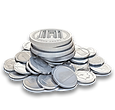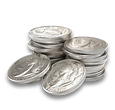🧠 How to Tell if a Coin is Real or Fake: The Ultimate Guide for Collectors & Investors
- GoldsilverJapan

- Aug 23
- 4 min read
Whether you're stacking silver, collecting ancient coins, or buying gold bullion for investment, knowing how to identify a fake coin is crucial. Counterfeit coins are unfortunately common—especially online or at flea markets—and failing to detect one could cost you hundreds or even thousands of dollars.
This article answers common search questions like:
“How can I tell if my coin is fake?”
“How do you verify a gold coin?”
“Is there an app or method to test coin authenticity at home?”
Let’s break it down step-by-step.
🔍 Why You Should Be Suspicious
Before we get into how to test coins, let’s get one thing clear:
If a deal sounds too good to be true… it probably is.
With rising prices in gold, silver, and rare coins, counterfeiters have become more sophisticated, using advanced techniques and cheap base metals to mimic the real thing. Even common bullion coins like American Silver Eagles or Maple Leafs are now being faked in large numbers.
🧪 1. Test the Weight and Dimensions
Authentic coins have precise weight and diameter. Any deviation could be a red flag.
How to Check:
Use a digital scale with at least 0.01g accuracy.
Use a digital caliper to measure diameter and thickness.
Compare to official specs from the issuing mint.
📌 Example:A genuine 1 oz American Silver Eagle weighs 31.1g and is 40.6mm in diameter.If your coin weighs 28g or is too thick/thin—it’s likely fake.
🧲 2. Do the Magnet Test
Most real precious metals (gold, silver, platinum) are non-magnetic.
How to Do It:
Use a strong neodymium magnet.
Tilt the coin at 45 degrees and slide the magnet down the face.
If it sticks hard or slides too quickly—it may contain steel or nickel.
⛔ Caution:Some counterfeiters use non-magnetic metals like lead or copper, so this isn’t a stand-alone test.
🎧 3. The Ping (Sound) Test
Real silver and gold have a distinct, high-pitched ring when tapped.
How to Test:
Balance the coin on your finger and tap it with another coin or a plastic pen.
Listen to the sound: Real silver rings; fakes often produce a dull thud.
There are even mobile apps (like Coin Ping Test or Pingcoin) that analyze the frequency of the sound to help verify.
🔬 4. Use a Magnifying Glass or Jeweler’s Loupe
Details matter.
What to Look For:
Blurry or soft lettering
Uneven edge reeding (the ridges)
Incorrect fonts
Missing mint marks
Casting bubbles or seam lines
💡 Pro tip: Compare it side-by-side with a certified authentic coin or look up high-resolution images from the mint’s official website.
📊 5. Compare with a Verified Example
This is especially important for rare or numismatic coins.
What to Do:
Visit PCGS, NGC, or Numista to see certified photos.
Look up catalog numbers and minting years.
Match the coin’s features exactly.
Even small differences in design details or portrait features can indicate forgery.
🧪 6. Acid and Scratch Tests (Only as Last Resort)
If the coin has no collector value and you really need to know:
Silver test acid or gold test kits can verify the metal content.
However, they damage the coin and are not suitable for numismatics.
📲 7. Use Professional Tools or Services
If in doubt, get help.
Tools:
Sigma Metalytics Precious Metal Verifier – non-invasive, accurate metal analysis
XRF Gun (X-ray Fluorescence) – pro-level tool to analyze metal composition
Services:
PCGS or NGC coin grading and verification
Take it to a reputable coin dealer or bullion shop
🤖 8. Use AI-Powered Tools & Apps
There are emerging apps and services that let you:
Scan a coin with your phone camera
Compare it to a database of known fakes
These are evolving fast and worth watching.
🔒 9. Buy From Reputable Sources Only
Prevention is the best strategy.
Buy from:
Reputable bullion dealers (like APMEX, JM Bullion, Kitco, etc.)
Certified coin shops
Graded coins from PCGS/NGC/ANACS with a valid serial number
Avoid:
eBay sellers with vague descriptions
Craigslist/Facebook Marketplace
Suspiciously cheap “mint fresh” offers
❌ Common Mistakes When Trying to Spot a Fake Coin
Relying only on the magnet test
Ignoring small differences in design or edge
Trusting seller “certificates” without verification
Thinking only rare coins are faked – even modern bullion coins are counterfeited
🙋 Frequently Asked Questions (FAQ)
Q: Can fake coins have real silver?
A: Some fakes are silver-plated but not solid. These will fail the weight and ping tests.
Q: Is it illegal to own a fake coin?
A: No, unless you sell or pass it off as real. It’s best to mark them clearly as counterfeit.
Q: Are slabbed coins always safe?
A: Usually, yes—if the slab is from PCGS, NGC, or ANACS. Beware of fake slabs (yes, they exist too!).
🧭 Final Thoughts: Stay Sharp, Not Sorry
Fake coins are getting better—and more common. But with the right tools and knowledge, you can avoid getting scammed. Always:
Know what you're buying
Compare to official specs
Use multiple tests
Buy from trusted sources
Whether you're investing or collecting, learning how to spot a fake coin is essential coin knowledge.
👉 Want to test your coin? Consider sending it to PCGS or NGC for professional authentication.











Comments